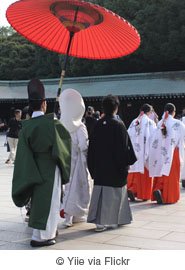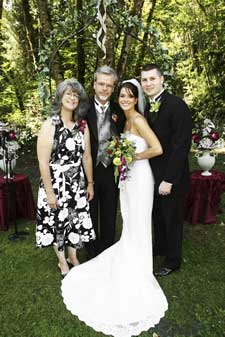Births, deaths, and marriages: are there any events more universal to the human experience?
Students from all over the world enroll in our Wedding Planning course; a small reminder that marriage truly is a common human tradition. But while every marriage is and has always been essentially the same – a ritual or ceremony bonding the couple and a party with friends and family to celebrate – the details differ widely, and delightfully, across cultures.
The ceremony or ritual surrounding the actual "marriage" is often rooted in religious tradition, and incorporates ancient texts and symbols. Many customs are meant to signify the joined and everlasting bond of marriage. The wedding ring, used in woven grass form by the ancient Egyptians, and in cast iron or gold by the Greeks and Romans, is a symbol of infinity. In traditional Latin American weddings, the bride and groom are physically bound together with a rosary, white lasso, or heirloom mantilla woven in a figure-eight around their bodies. In Laos, couples visit with monks on the day before their reception, where cotton thread is used to bind their wrists to each other and to the monks.
Other ceremonial traditions call for the couple to share a sacred food or drink. In Catholic ceremonies, the couple participates in a communion meal of bread and wine, and in Jewish ceremonies the couple is blessed while drinking wine from a shared wedding Kiddush cup. In Japan, Shinto couples drink nine sips of sake as part of their nuptial rites, presented to them by children of the shrine.
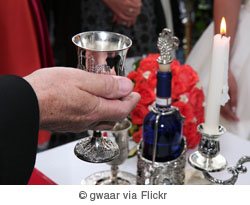
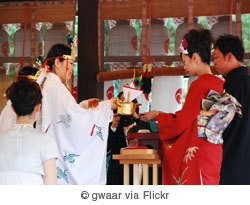
Many marriage customs are intended to symbolize the start of a new life and family together. Scottish couples exchange family tartans or plaids. In Japan, it is the families that face each other during the ceremony, not just the bride and groom. African-American couples join hands and jump over a broom, a tradition created by slaves to symbolize the act of stepping over a threshold into a new life.
Traditional wedding attire also varies wonderfully across cultures. While American brides almost exclusively opt for white or ivory, brides in other parts of the world are all about color – and lots of it. Red is a lucky color in many parts of Asia, which makes it a perfect and popular choice for brides. In Japan, traditional brides wear an uchikake, a formal kimono reserved for weddings and theater. Made of thick, brocaded material and created with a heavy hem meant to drag along the floor, the uchikake is the outermost layer of the bridal costume. While the fabric is often white, the lining is almost always a vibrant red.
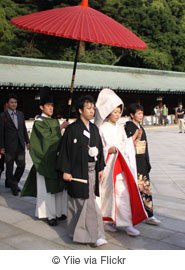
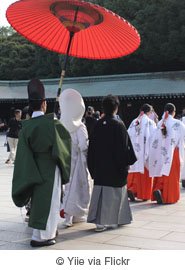
Chinese couples also favor red, the color of love and joy, for the bride. The color is used for attire, including the bride's shoes, as well as for paper goods and favors that incorporate the Chinese symbol for "double happiness."
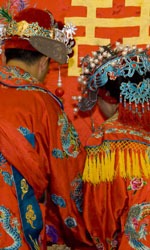

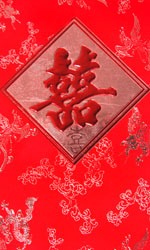
In Vietnam, brides often wear elaborate Ao dai dresses, the country's traditional costume. The wedding ao dai is red or pink, and may be embroidered with symbolic animals or motifs and topped with an additional coat. An intricately embroidered kaftan is choice of Moroccan (and many Arabic) brides. This long-sleeved, full-length garment is often white, but is also popular in rich jewel tones like fuchsia and emerald.
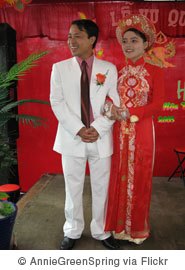
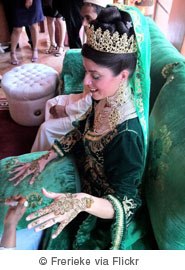
Perhaps no attire is as extravagant and extroverted as that of the Indian nuptial couple. Indians are not shy about vibrant color, and Indian brides almost never wear white. On the contrary, shades of yellow and burgundy are popular – but the rainbow is really the limit. Regardless of color, wedding saris are invariably adorned with exquisite silver and gold details. Elaborate headdresses, flowers, jewelry, and other adornments are also popular with Indian brides and grooms.
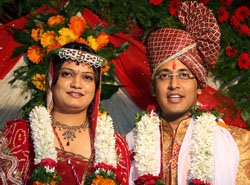
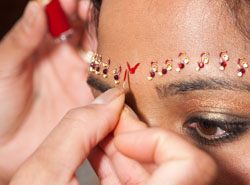
Henna painting on the bride's skin is a common practice in Hindu and Muslim weddings. The plant-based dye is used to draw floral and geometric designs on the women's hands, arms, and feet. Many cultures believe the designs bring luck, increase fertility, and ward off evil.
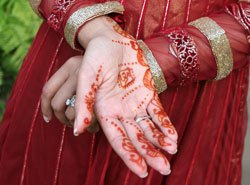
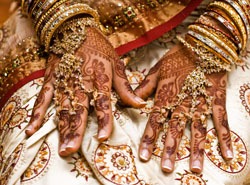
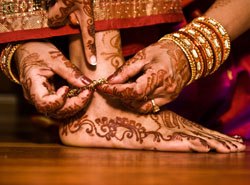
No celebration, wedding or otherwise, would be complete without a feast and some sweets. Whether a traditional symbol of fertility or just a wish for a sweet life for the couple, the cutting, sharing, and enjoying of the wedding cake is a perfect way to "break bread" with family and friends. As with all food, wedding cake is an expression of culture, and varies widely around the globe.
In France, the cake is not really a cake at all, but a shimmering tower of cream puffs drizzled with caramel called a croquembouche (meaning "crunch in the mouth"). Vietnamese guests enjoy "husband and wife" cake known as Phu The. Created from a sticky combination of tapioca flour, bean paste, sugar, and coconut milk, the Phu Thes are wrapped in coconut palm leaves in the shape of a tiny gift.
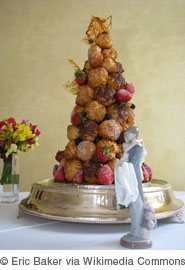
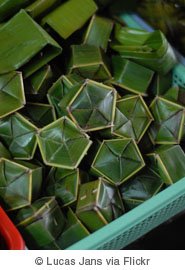
Traditional English and Irish brides enjoy dense, spirit-soaked fruitcakes on their wedding days, as do the Scottish – but the Scots take their cake more seriously. The two tiers of a Scottish wedding cake are baked when the couple is first engaged, and kept until the wedding day with a generous soaking of brandy. Only one tier is eaten at the wedding – the other is reserved for the occasion of the couples' first born.
Krasenkage, or ring cake, is the traditional cake eaten at a Norwegian celebration. This marzipan-flavored delicacy is created from concentric rings of cake stacked to form a tower. The version used at weddings is a cornucopia of delights – candies, cookies, and other treats such as a bottle of wine are tucked inside the hollow center, ensuring an enduring good time.
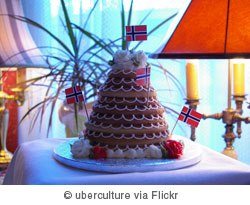
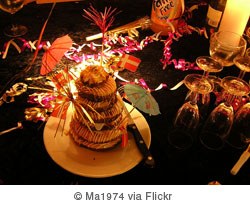
Brides and grooms around the world have endless opportunities to incorporate cultural rituals, foods, and customs into every aspect of their wedding, from the ceremony to the sweet end of the reception. In so doing, they keep wonderful traditions alive for generations to come.


